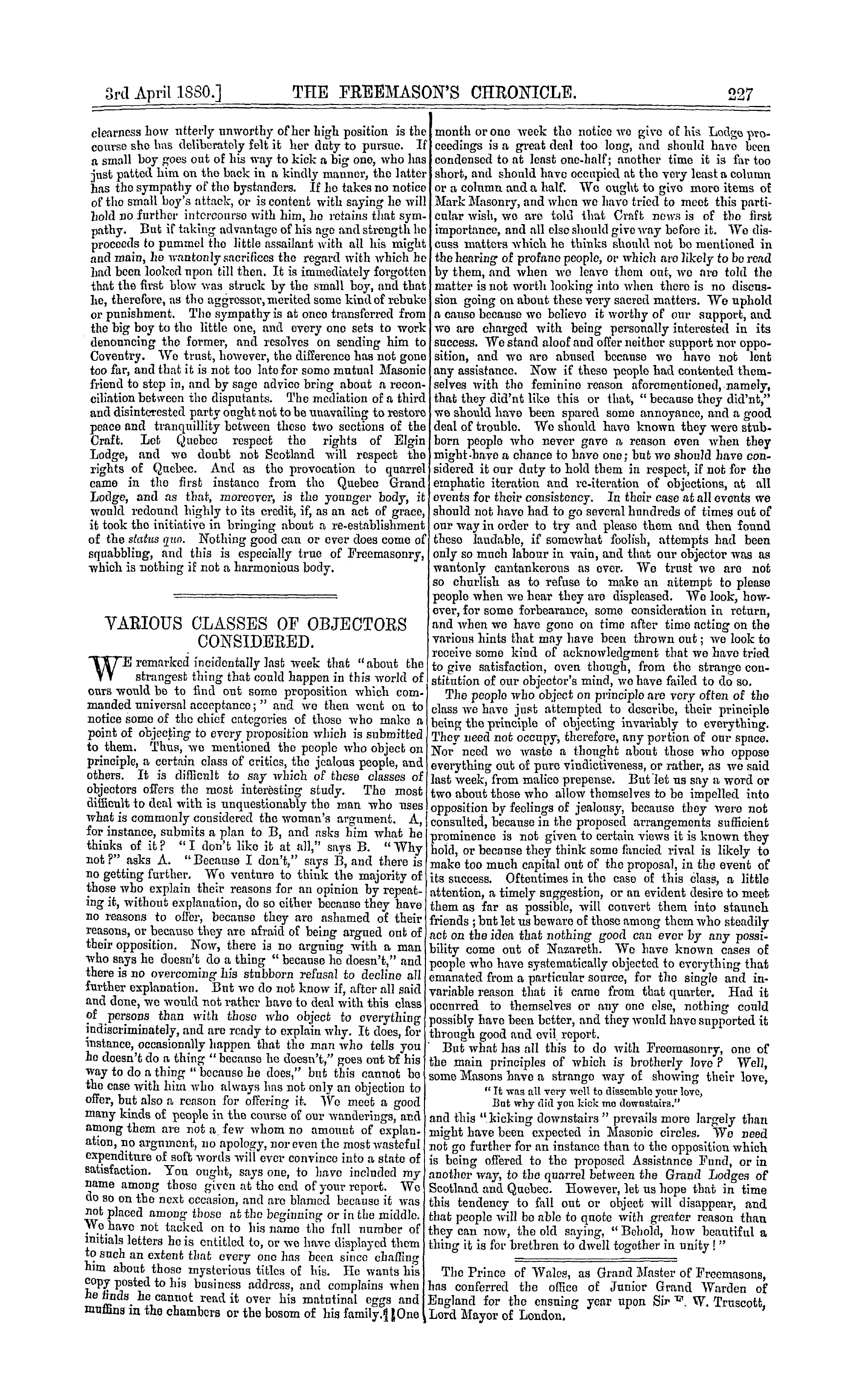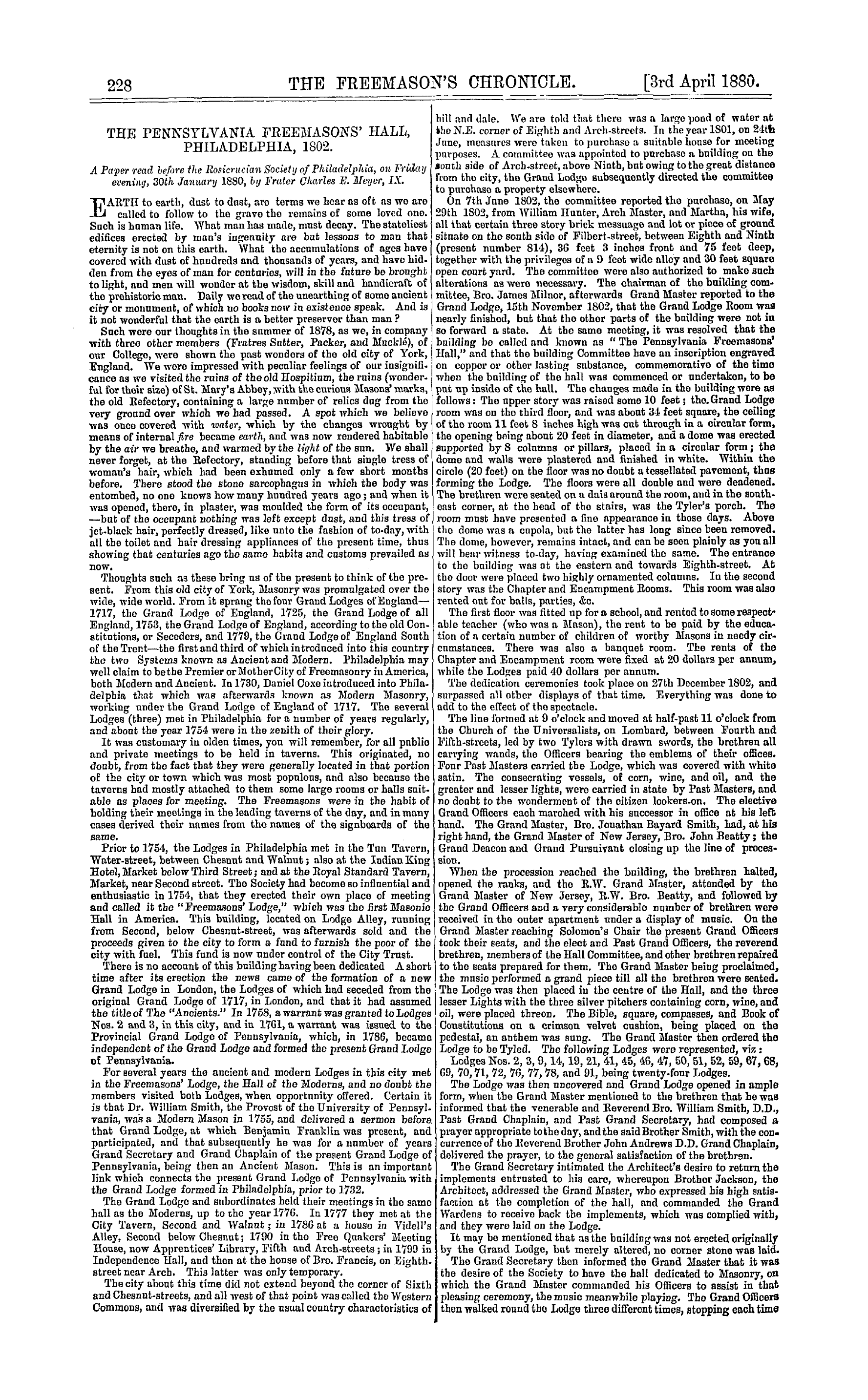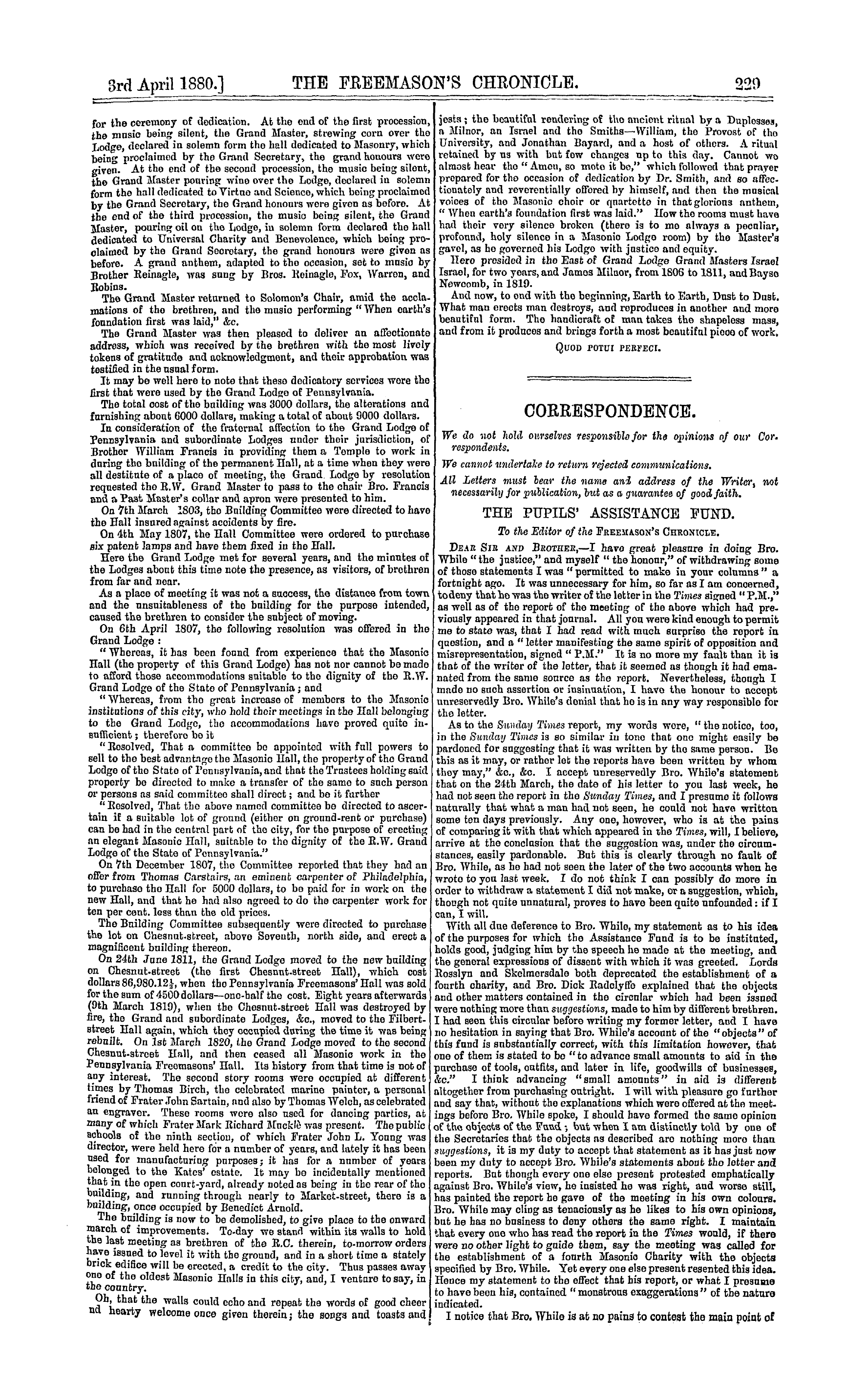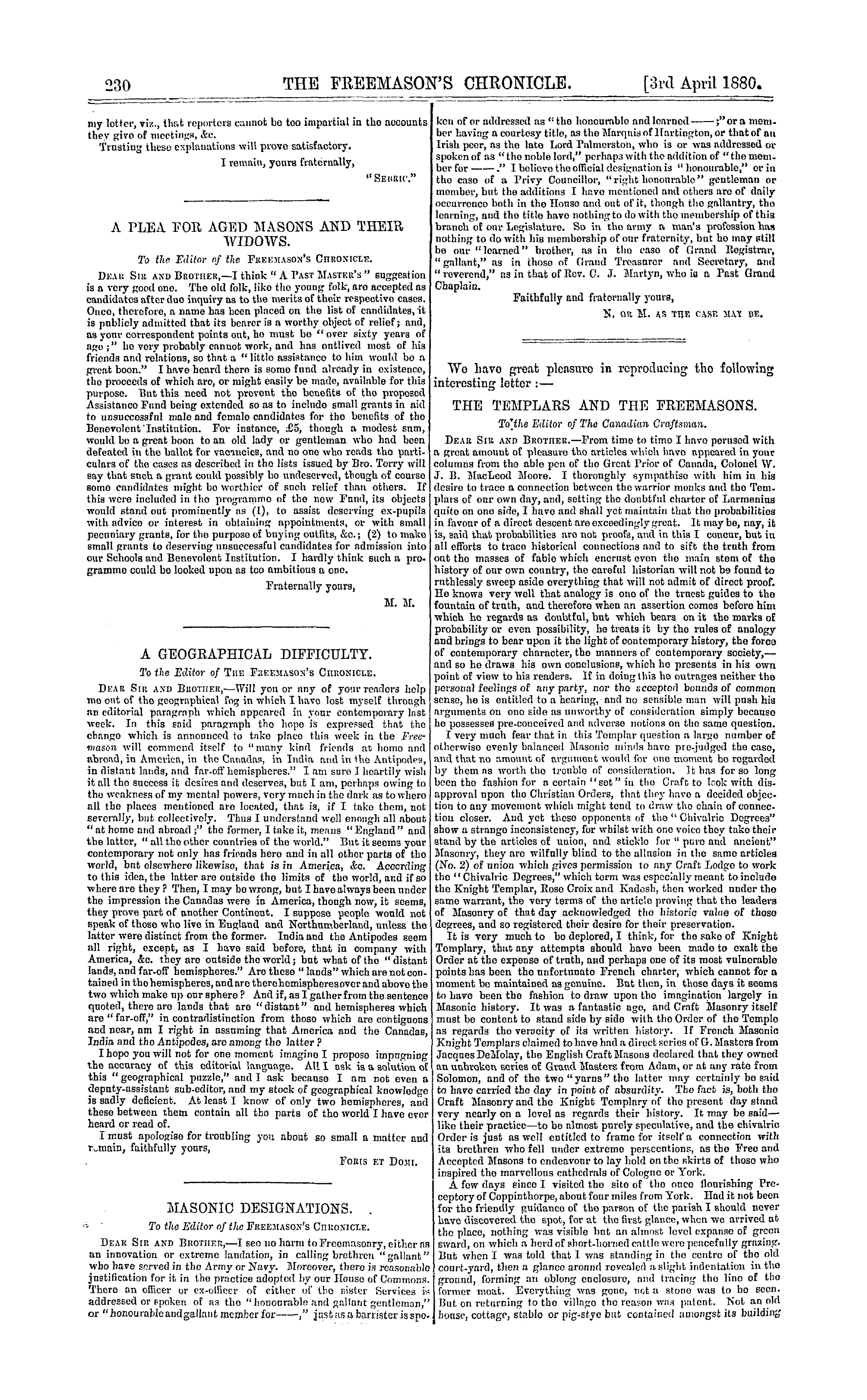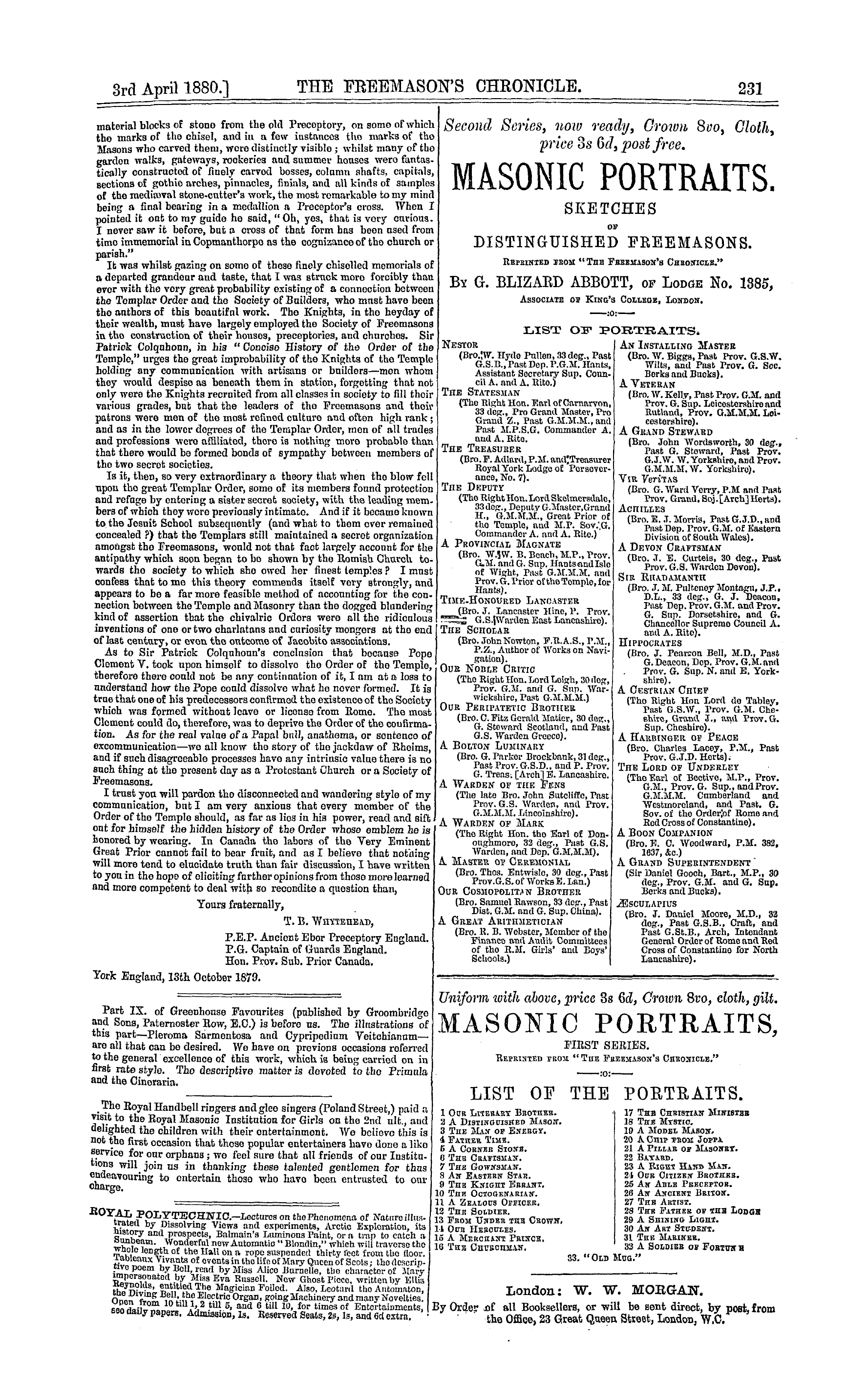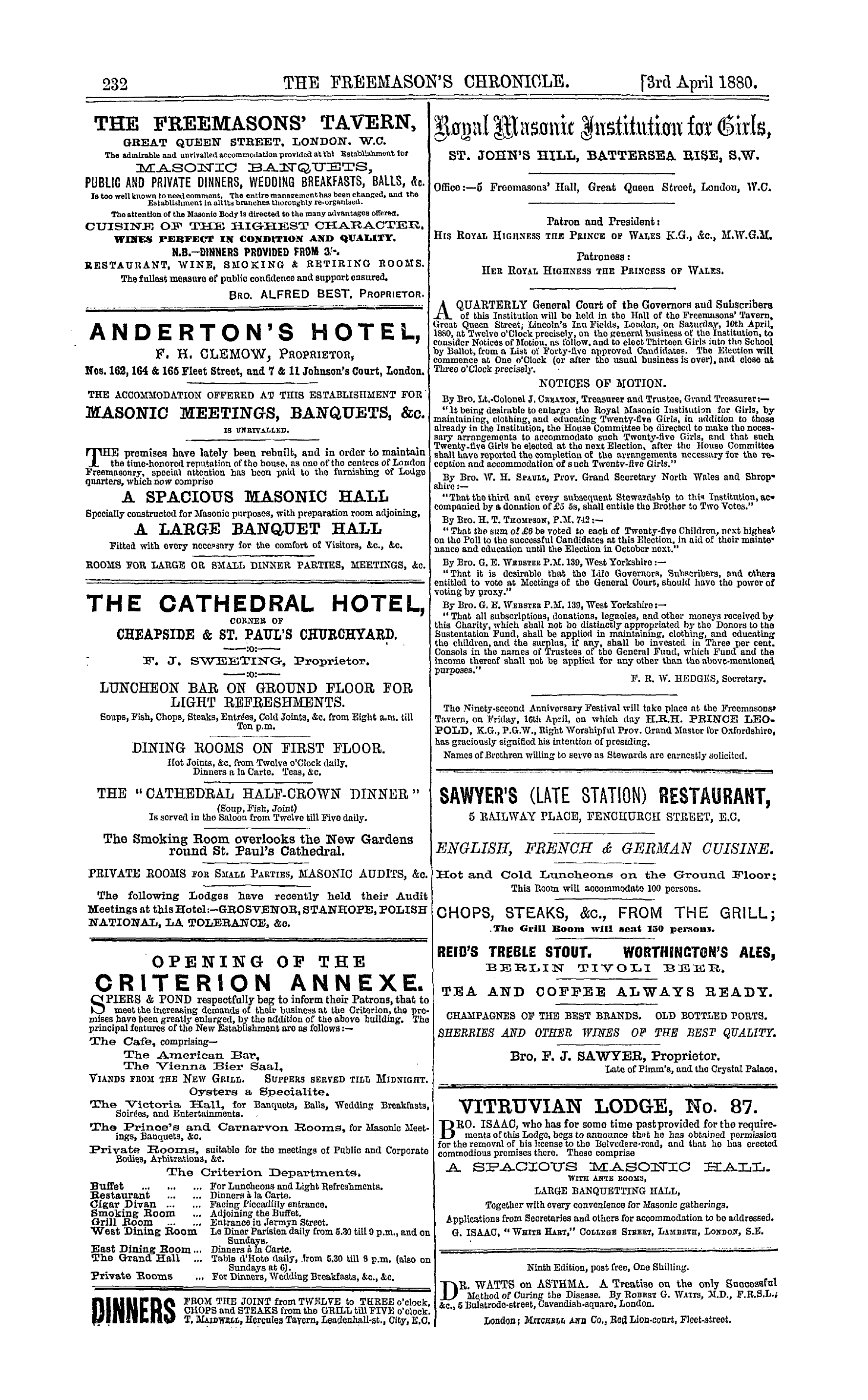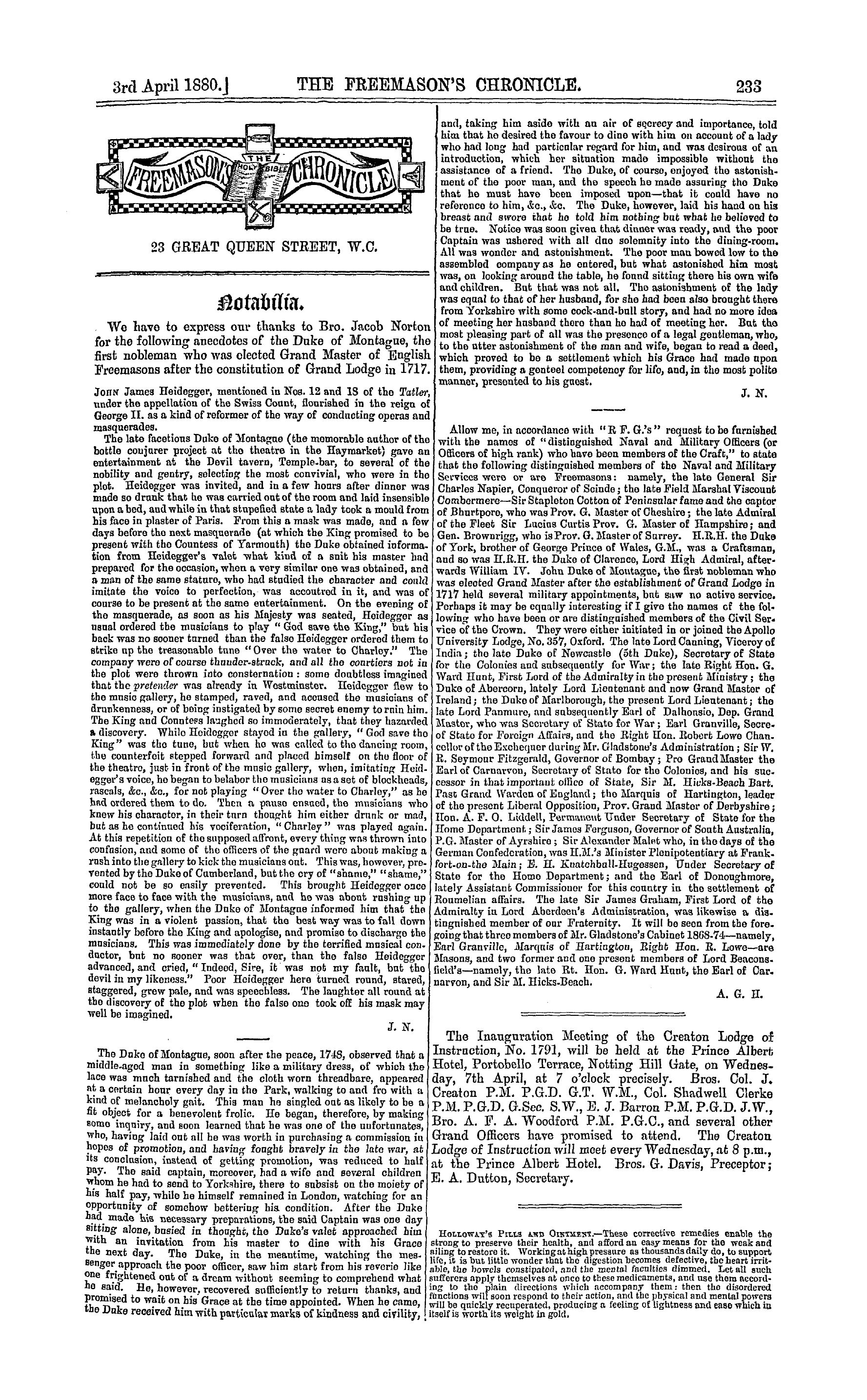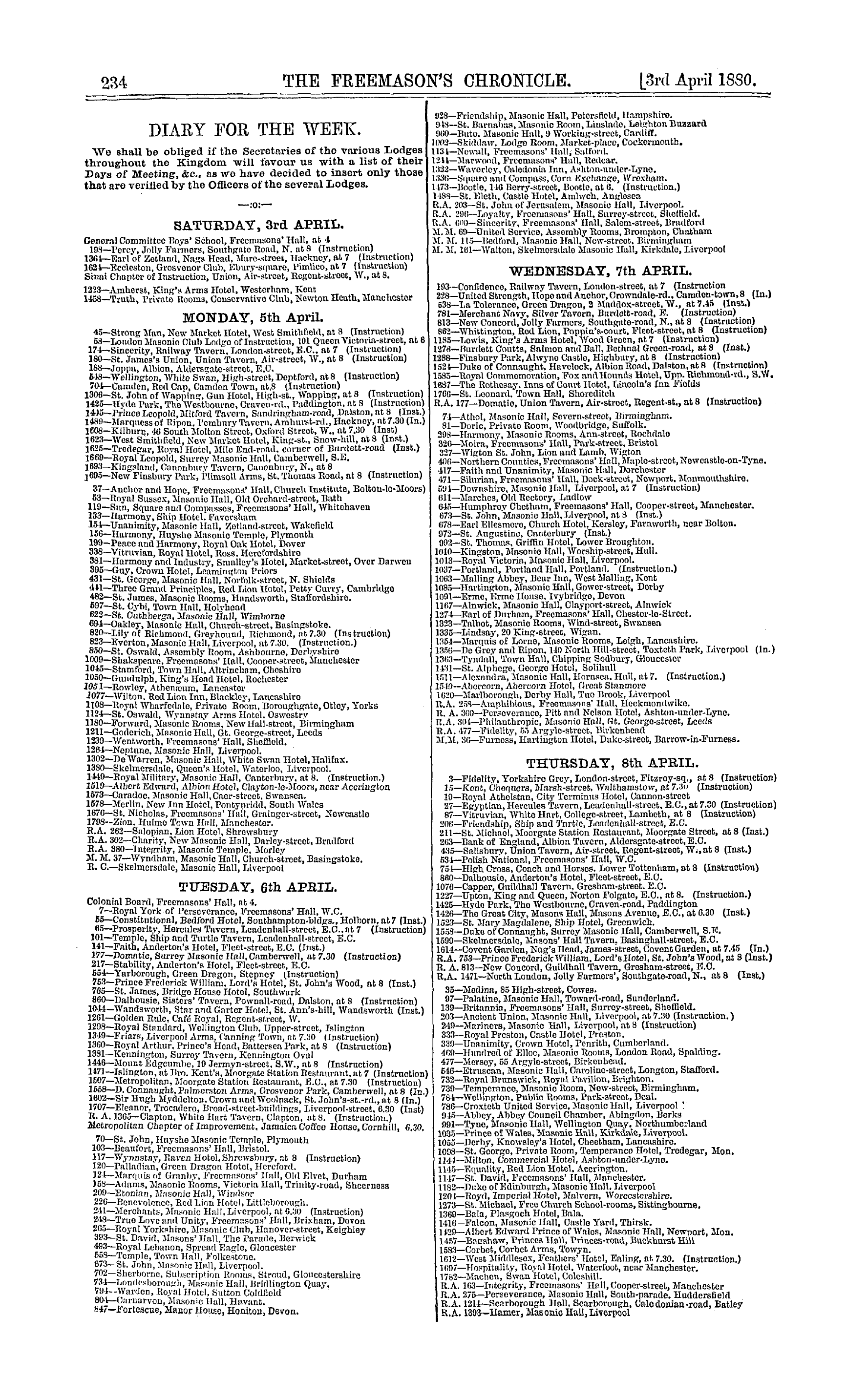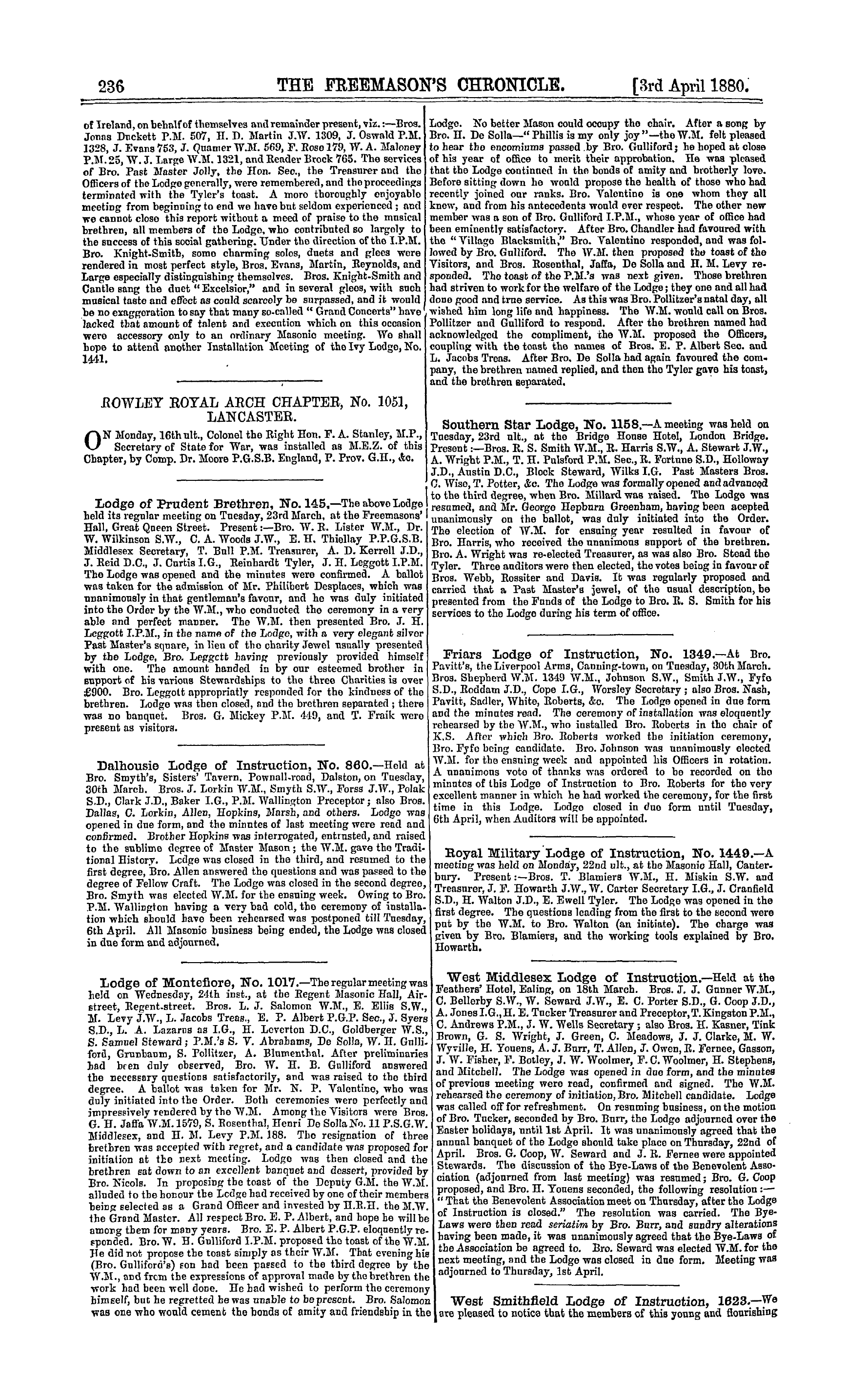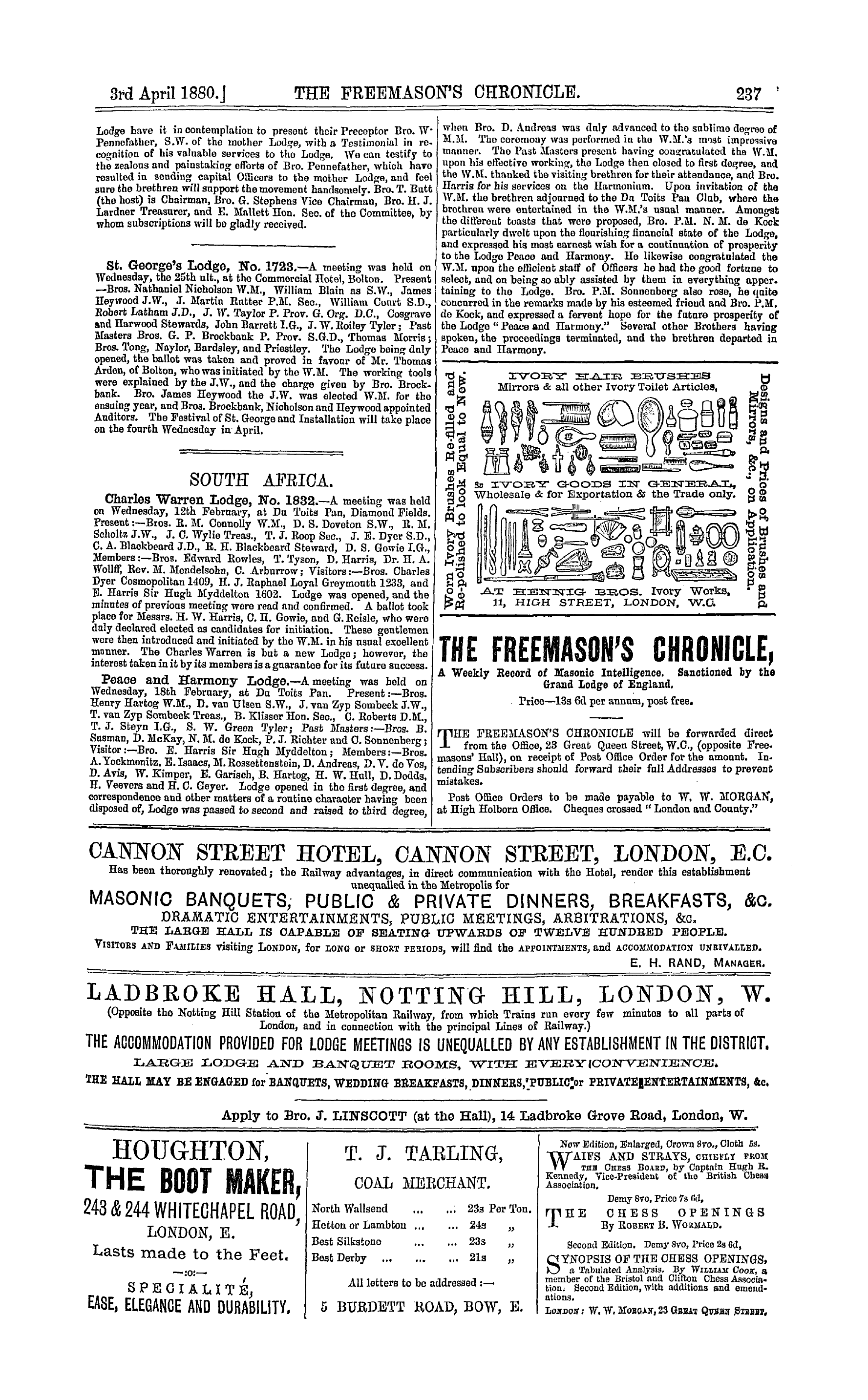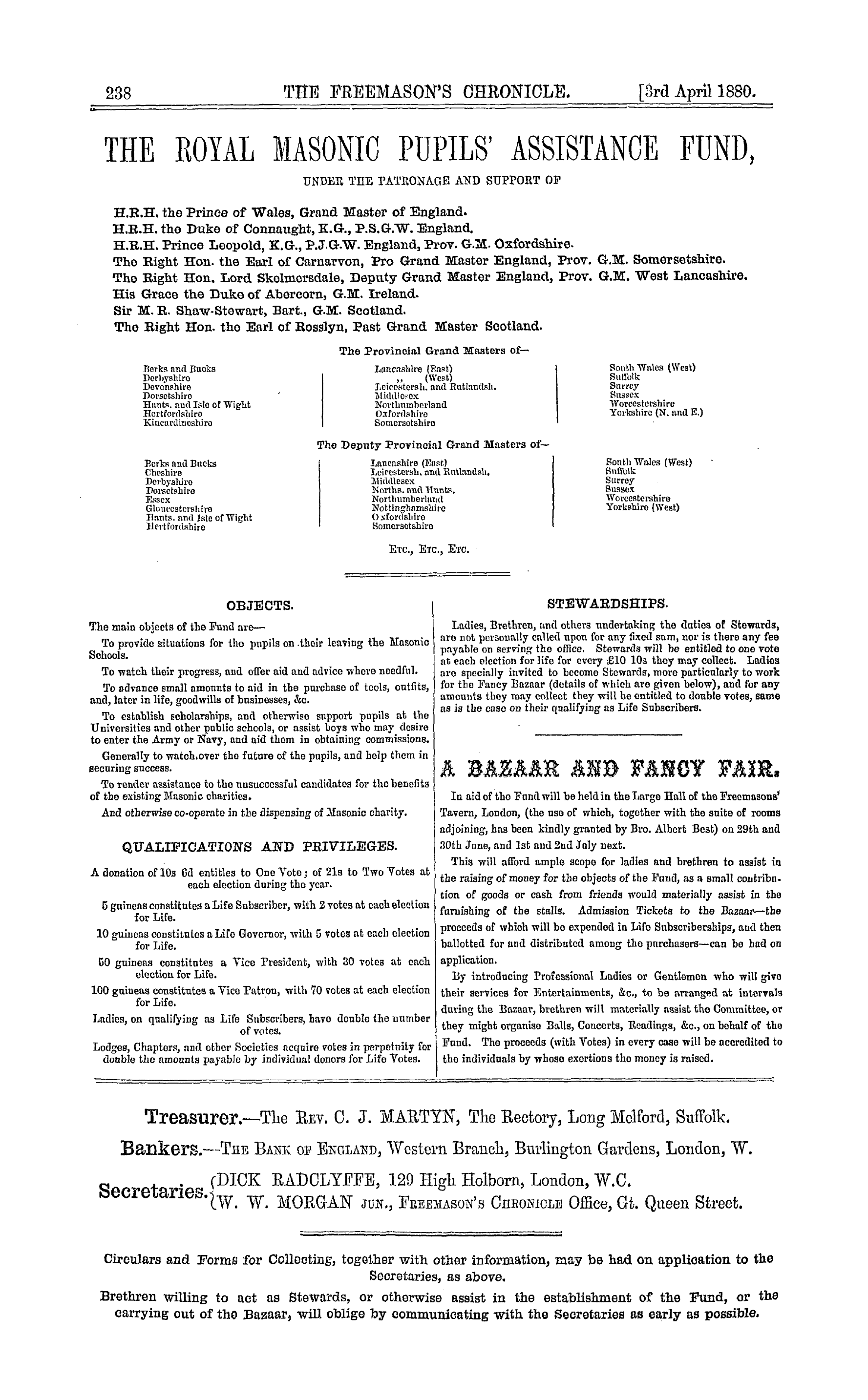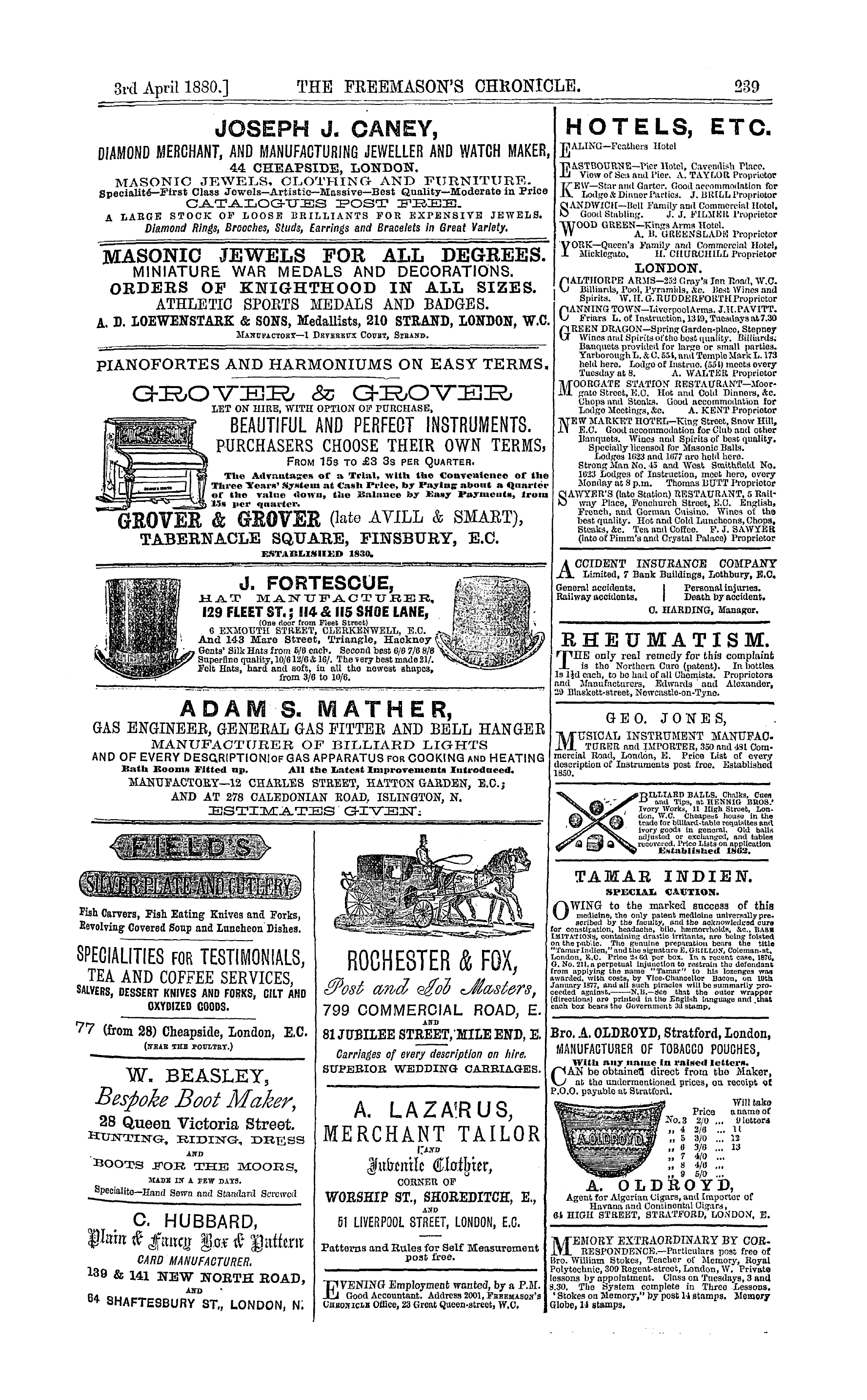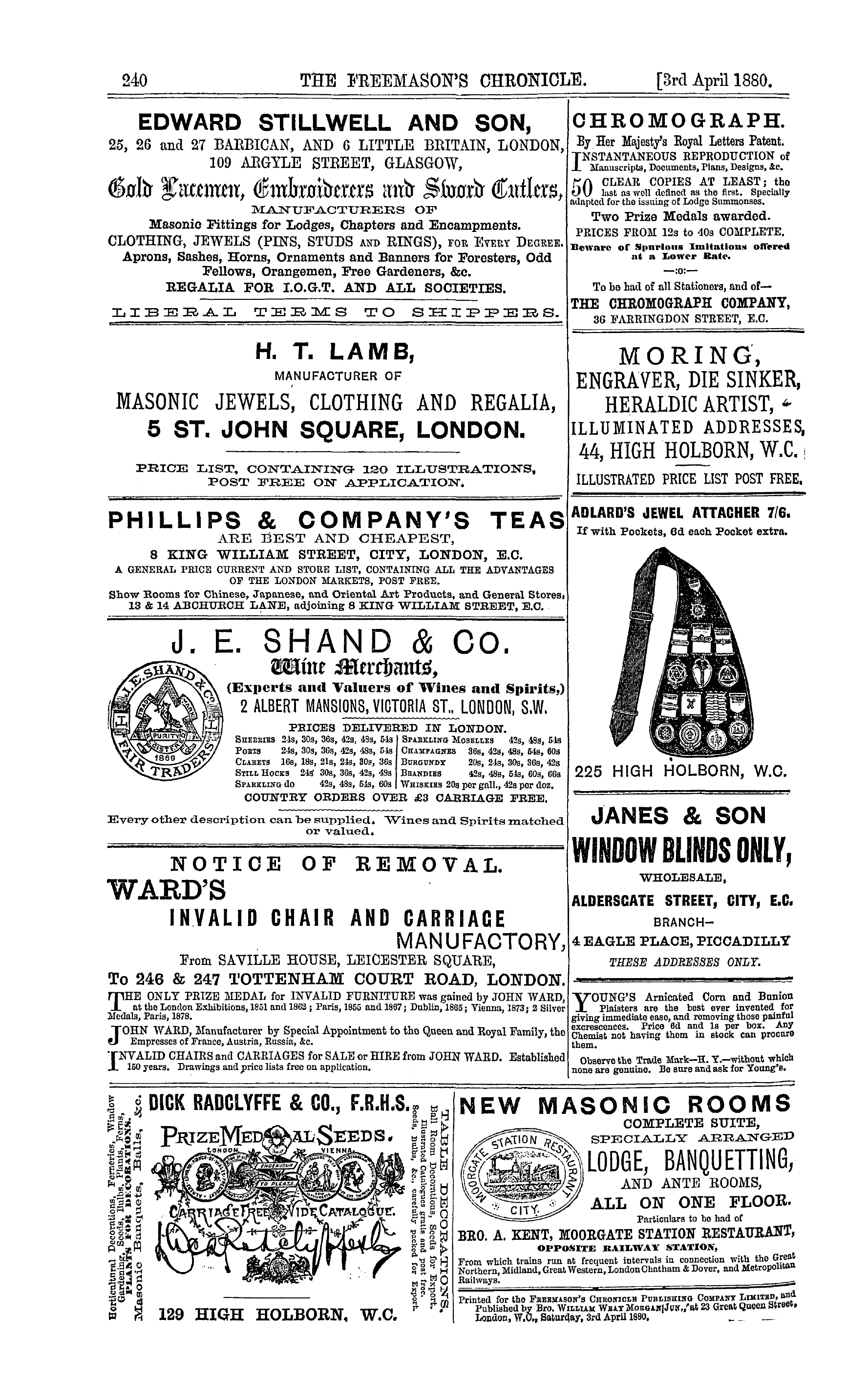Note: This text has been automatically extracted via Optical Character Recognition (OCR) software.
The Pennsylvania Freemasons' Hall, Philadelphia, 1802.
THE PENNSYLVANIA FREEMASONS' HALL , PHILADELPHIA , 1802 .
A Paper read before the Rosicrucian Society of Philadelphia , ou Friday evening , 30 th January 1830 , by Frater Charles E . Meyer , IX . EAETII to earth , dust to dust , aro terms wo hear as oft as wo aro called to follow to tho grave the remains of some loved one . Such is human life . What man has made , must decay . The stateliest edifices erected by man ' s ingenuity are but lessons to man that
eternity is not on this earth . What tho accumulations of ages have covered with dust of hundreds and thousands of years , and havo hidden from the eyes of man for centuries , will in tho future bo brought to light , and men will wonder at the wisdom , skill and handicraft of the prehistoric mail . Daily wo read of the unearthing of somo ancient city or monument , of which no books now in existence speak . And is
it not wonderful that the earth is a better preserver than man ? Such wero our thoughts in the summer of 1878 , as we , in company with three other members ( Fratres Sutter , Packer , and Muckle ) , of our College , wero shown tho past wonders of tho old city of York , England . We were impressed with peculiar feelings of our insignificance as we visited the ruins of the old Hospitium , the ruins (
wonderful for their size ) of St . Mary ' s Abbey , with tho curious Masons marks , tho old Eefectory , containing a large number of relics dug from the very ground over which wo had passed . A spot which we believe was once covered with water , which by the changes -wrought by means of internal fire became earth , and was now rendered habitable by the air we breathe , and warmed by the light of the sun . We shall never forget , at the Eefectory , standing before that single tress of
woman ' s hair , which had been exhumed only a few short months before . There stood the stone sarcophagus in which the body was entombed , no one knows how many hundred years ago ; and when it was opened , there , in plaster , was moulded the form of its occupant , —but of the occupant nothing was left except dust , and this tress of jet-black hair , perfectly dressed , like unto the fashion of to-day , with all the toilet and hair dressing appliances of the preseut time , thus showing that centuries ago tho same habits and customs prevailed as
now . Thoughts such as theso bring us of the present to think of the present . From this old city of York , Masonry was promulgated over the wide , wide world . From it sprang the four Grand Lodges of England—1717 , the Grand Lodge of England , 1725 , the Grand Lodge of all England , 1753 , the Grand Lodge of England , according to the old
Constitutions , or Seceders , and 1779 , the Grand Lodge of England South of the Trent—the first and third of which introduced into this country tho two Systems known as Ancient and Modern . Philadelphia may well claim to betbe Premier or MotherCity of Freemasonry iu America , both Modern and Ancient . In 1730 , Daniel Coxe introduced into Philadelphia that which was afterwards knovvn as Modern Masonry ,
working nnder the Grand Lodge of England of 1717 . The several Lodges ( three ) met in Philadelphia for a number of years regularly , and about the year 1754 were in the zenith of their glory . It was customary in olden times , yon will remember , for all public and private meetings to be held in taverns . This originated , no
doubt , from the fact that they were generally located in that portion of the city or town which was most populous , and also because the taverns had mostly attached to them some large rooms or halls suitable as places for meeting . The Freemasons were in the habit of holding their meetings in the leading taverns of the day , and in many cases derived their names from the names of tho signboards of tho
same . Prior to 1754 , the Lodges in Philadelphia met in the Tun Tavern , "Water-street , between Chesnut and Walnut ; also at tho Indian King Hotel , Market below Third Street j and at the Eoyal Standard Tavern , Market , near Second street . The Society had become so influential and enthusiastic in 1754 , that they erected their own placo of meeting
and called it tbe " Freemasons Lodge , " which was tho first Masonic Hall in America . This building , located on Lodge Alley , running from Second , below Chesnut-street , was afterwards sold and the proceeds given to the city to form a fund to furnish the poor of the city with fuel . This fund is now under control of the City Trust . There is no account of this building having been dedicated A short time after its erection the news came of the formation of a new
Grand Lodge in London , the Lodges of which had seceded from the original Grand Lodge of 1717 , in London , and that it had assumed the title of The "Ancients . " In 1758 , a warrant was granted to Lodges "Nos . 2 and 3 , in this city , and in 17 G 1 , a warrant was issued to the Provincial Grand Lodge of Pennsylvania , which , in 1786 , became independent of the Grand Lodge and formed the present Grand Lodge
ot Pennsylvania . For several years the ancient and modern Lodges in this city met in the Freemasons' Lodge , the Hall of the Moderns , and no doubt the members visited both Lodges , when opportunity offered . Certain it is that Dr . William Smith , the Provost of the University of Pennsylvania , was a Modern Mason in 1755 , and delivered a sermon before .
that Grand Lodge , at which Benjamin Franklin was present , and participated , and that subsequently he was for a number of years Grand Secretary and Grand Chaplain of the present Grand Lodge of Pennsylvania , being then an Ancient Mason . This is an important link which connects the present Grand Lodgo of Pennsylvania with the Grand Lodge formed in Philadelphia , prior to 1732 .
Tho Grand Lodge and subordinates held their meetings in the same hall as the Moderns , up to tho year 1776 . In 1777 they met at the City Tavern , Second and Walnut ; in 1786 at a house in "Videll ' s Alley , Second below Chesnut ; 1790 in tho Free Quakers' Meeting House , now Apprentices' Library , Fifth and Arch-streets ; in 1799 in
Independence Hall , and then at the house of Bro . Francis , on Eighth , street near Arch . This latter was only temporary . The city about this time did not extend beyond tho corner of Sixth and Chesnnt-streets , and all west of that point waa called the Western Commons , and was diversified by the usual country characteristics of
The Pennsylvania Freemasons' Hall, Philadelphia, 1802.
hill and dale . We are told that thero was a largo pond of water at the N . E . corner of Eighth and Arch-streets . In the year 1801 , on 24 tf ) June , measures were taken to purchase a suitable house for meeting purposes . A committee was appointed to purchase a building on tho south side of Arch-street , above Ninth , but owing to the great distance from the city , the Grand Lodge subsequently directed the committee
to purchase a property elsewhere . On 7 th June 1802 , the committee reported tho purchase , on May 29 th 1802 , from William Hunter , Arch Master , and Martha , his wife , all that certain three story brick messuage and lot or piece of ground situate on the south sido of Filbert-street , between Eighth and Ninth ( present number 814 ) , 36 feet 3 inches front and 75 feet deep ,
together with tho privileges of a 9 feot wide alley and 30 feet square open court yard . The committee wero also authorized to make such alterations as wero necessary . The chairman of tho building committee , Bro . James Milnor , afterwards Grand Master reported to the Grand Lodge , 15 th November 1802 , that the Grand Lodge Eoom was nearly finished , but that tho other parts of the building were not in
so forward a state . At tho same meeting , it was resolved that the building bo called and known as " The Pennsylvania Freemasons ' Hall , " and that tho building Committee have an inscription engraved on copper or other lasting substance , commemorative of the time when the building of tho hall was commenced or undertaken , to be put up insido of the hall . The changes made in the building were as
follows : Tho upper story was raised some 10 feet ; tho . Grand Lodgo room was on tho third floor , and was about 34 feet square , tho ceiling of tho room 11 feet 8 inches high was cut through in a circular form , the opening being about 20 feet in diameter , and a dome was erected supported by 8 columns or pillars , placed in a circular form ; the dome and walls were plastered and finished in white . Within the
circle ( 20 feet ) on the floor was no doubt a tessellated pavement , thus forming tho Lodge . Tho floors were all double and wero deadened . The brethren were seated on a dais around the room , and in the southeast corner , at tho head of tho stairs , was the Tyler ' s porch . The room must have presented a fine appearance iu those days . Above tho dome was a cupola , but the latter has long since been removed .
The dome , however , remains intact , and can be seen plainly as you all will bear witness to-day , haviug examined the same . The entrance to tho building was at the eastern and towards Eighth-street . Ab tho door were placed two highly ornamented columns . In the second story was the Chapter and Encampment Eooms . This room was also rented out for balls , parties , & c .
The first floor was fitted up for a school , and rented to some respectable teacher ( who was a Mason ) , the rent to be paid by the education of a certain number of children of worthy Masons in needy circumstances . There was also a banquet room . The rents of the Chapter and Encampment room were fixed at 20 dollars per annum , while the Lodges paid 40 dollars per annum .
The dedication ceremonies took place on 27 th December 1802 , and surpassed all other displays of that time . Everything was done to add to the effect of tho spectacle . The line formed at 9 o ' clock and moved at half-past 11 o ' clock from the Church of the TJniversalists , on Lombard , between Fourth and
Fifth-streets , led by two Tylers with drawn swords , the brethren all carrying wands , the Officers bearing the emblems of their offices . Four Past Masters carried the Lodge , which was covered with whito satin . The consecrating vessels , of corn , wine , and oil , and the greater and lesser lights , wero carried in state by Past Masters , and no doubt to the wonderment of the citizen lookers-on . The elective
Grand Officers each marched with his successor in office at his left hand . The Grand Master , Bro . Jonathan Bayard Smith , had , at his right hand , the Grand Master of New Jersey , Bro . John Beatty ; the Grand Deacon and Grand Pursuivant closing up the lino of procession . When the procession reached the building , the brethren halted ,
opened the ranks , and the E . W . Grand Master , attended by the Grand Master of New Jersey , E . W . Bro . Beatty , and followed by the Grand Officers and a very considerable number of brethren were received in the outer apartment under a display of music . On the Grand Master reaching Solomon ' s Chair the present Grand Officers took their seats , and the elect and Past Grand Officers , the reverend brethren , members of the Hall Committee , and other brethren repaired
to the seats prepared for them . The Grand Master being proclaimed , the music performed a grand piece till all the brethren were seated . The Lodge was then placed in tho centre of the Hall , and the three lesser Lights with the three silver pitchers containing corn , wine , and oil , were placed threon . The Bible , square , compasses , and Book of Constitutions on a crimson velvet cushion , being placed on the pedestal , an anthem was sung . The Grand Master then ordered the Lodge to be Tyled . The following Lodges were represented , viz : Lodges Nos . 2 , 3 , 9 , 14 , 19 , 21 , 41 , 45 , 46 , 47 , 50 , 51 , 52 , 59 , 67 , 68 ,
69 , 70 , 71 , 72 , 76 , 77 , 78 , and 91 , being twenty-four Lodges . The Lodgo was then uncovered and Grand Lodge opened in ample form , when the Grand Master mentioned to tho brethren that he was informed that the venerable and Eeverend Bro . William Smith , D . D ., Past Grand Chaplain , and Past Grand Secretary , had composed a prayer appropriate tothe day , and the said Brother Smith , with the con
currence of the Eeverend Brother John Andrews D . D . Grand Chaplain , delivered the prayer , to the general satisfaction of the brethren . The Grand Secretary intimated the Architect ' s desire to return the implements entrusted to his care , whereupon Brother Jackson , tho Architect , addressed the Grand Master , who expressed bis high satisfaction at the completion of the hall , and commanded the Grand Wardens to receive back the implements , which was complied with ,
and they were laid on the Lodge . It may bo mentioned that as the building was not erected originally by the Grand Lodge , but merely altered , no corner stone was laid . The Grand Secretary then informed tho Grand Master that it was the desire of the Society to have the hall dedicated to Masonry , on which the Grand Master commanded his Officers to assist in that pleasing ceremony , the music meanwhile playing . Tho Grand Officers then walked round the Lodge three different times , stopping each time
Note: This text has been automatically extracted via Optical Character Recognition (OCR) software.
The Pennsylvania Freemasons' Hall, Philadelphia, 1802.
THE PENNSYLVANIA FREEMASONS' HALL , PHILADELPHIA , 1802 .
A Paper read before the Rosicrucian Society of Philadelphia , ou Friday evening , 30 th January 1830 , by Frater Charles E . Meyer , IX . EAETII to earth , dust to dust , aro terms wo hear as oft as wo aro called to follow to tho grave the remains of some loved one . Such is human life . What man has made , must decay . The stateliest edifices erected by man ' s ingenuity are but lessons to man that
eternity is not on this earth . What tho accumulations of ages have covered with dust of hundreds and thousands of years , and havo hidden from the eyes of man for centuries , will in tho future bo brought to light , and men will wonder at the wisdom , skill and handicraft of the prehistoric mail . Daily wo read of the unearthing of somo ancient city or monument , of which no books now in existence speak . And is
it not wonderful that the earth is a better preserver than man ? Such wero our thoughts in the summer of 1878 , as we , in company with three other members ( Fratres Sutter , Packer , and Muckle ) , of our College , wero shown tho past wonders of tho old city of York , England . We were impressed with peculiar feelings of our insignificance as we visited the ruins of the old Hospitium , the ruins (
wonderful for their size ) of St . Mary ' s Abbey , with tho curious Masons marks , tho old Eefectory , containing a large number of relics dug from the very ground over which wo had passed . A spot which we believe was once covered with water , which by the changes -wrought by means of internal fire became earth , and was now rendered habitable by the air we breathe , and warmed by the light of the sun . We shall never forget , at the Eefectory , standing before that single tress of
woman ' s hair , which had been exhumed only a few short months before . There stood the stone sarcophagus in which the body was entombed , no one knows how many hundred years ago ; and when it was opened , there , in plaster , was moulded the form of its occupant , —but of the occupant nothing was left except dust , and this tress of jet-black hair , perfectly dressed , like unto the fashion of to-day , with all the toilet and hair dressing appliances of the preseut time , thus showing that centuries ago tho same habits and customs prevailed as
now . Thoughts such as theso bring us of the present to think of the present . From this old city of York , Masonry was promulgated over the wide , wide world . From it sprang the four Grand Lodges of England—1717 , the Grand Lodge of England , 1725 , the Grand Lodge of all England , 1753 , the Grand Lodge of England , according to the old
Constitutions , or Seceders , and 1779 , the Grand Lodge of England South of the Trent—the first and third of which introduced into this country tho two Systems known as Ancient and Modern . Philadelphia may well claim to betbe Premier or MotherCity of Freemasonry iu America , both Modern and Ancient . In 1730 , Daniel Coxe introduced into Philadelphia that which was afterwards knovvn as Modern Masonry ,
working nnder the Grand Lodge of England of 1717 . The several Lodges ( three ) met in Philadelphia for a number of years regularly , and about the year 1754 were in the zenith of their glory . It was customary in olden times , yon will remember , for all public and private meetings to be held in taverns . This originated , no
doubt , from the fact that they were generally located in that portion of the city or town which was most populous , and also because the taverns had mostly attached to them some large rooms or halls suitable as places for meeting . The Freemasons were in the habit of holding their meetings in the leading taverns of the day , and in many cases derived their names from the names of tho signboards of tho
same . Prior to 1754 , the Lodges in Philadelphia met in the Tun Tavern , "Water-street , between Chesnut and Walnut ; also at tho Indian King Hotel , Market below Third Street j and at the Eoyal Standard Tavern , Market , near Second street . The Society had become so influential and enthusiastic in 1754 , that they erected their own placo of meeting
and called it tbe " Freemasons Lodge , " which was tho first Masonic Hall in America . This building , located on Lodge Alley , running from Second , below Chesnut-street , was afterwards sold and the proceeds given to the city to form a fund to furnish the poor of the city with fuel . This fund is now under control of the City Trust . There is no account of this building having been dedicated A short time after its erection the news came of the formation of a new
Grand Lodge in London , the Lodges of which had seceded from the original Grand Lodge of 1717 , in London , and that it had assumed the title of The "Ancients . " In 1758 , a warrant was granted to Lodges "Nos . 2 and 3 , in this city , and in 17 G 1 , a warrant was issued to the Provincial Grand Lodge of Pennsylvania , which , in 1786 , became independent of the Grand Lodge and formed the present Grand Lodge
ot Pennsylvania . For several years the ancient and modern Lodges in this city met in the Freemasons' Lodge , the Hall of the Moderns , and no doubt the members visited both Lodges , when opportunity offered . Certain it is that Dr . William Smith , the Provost of the University of Pennsylvania , was a Modern Mason in 1755 , and delivered a sermon before .
that Grand Lodge , at which Benjamin Franklin was present , and participated , and that subsequently he was for a number of years Grand Secretary and Grand Chaplain of the present Grand Lodge of Pennsylvania , being then an Ancient Mason . This is an important link which connects the present Grand Lodgo of Pennsylvania with the Grand Lodge formed in Philadelphia , prior to 1732 .
Tho Grand Lodge and subordinates held their meetings in the same hall as the Moderns , up to tho year 1776 . In 1777 they met at the City Tavern , Second and Walnut ; in 1786 at a house in "Videll ' s Alley , Second below Chesnut ; 1790 in tho Free Quakers' Meeting House , now Apprentices' Library , Fifth and Arch-streets ; in 1799 in
Independence Hall , and then at the house of Bro . Francis , on Eighth , street near Arch . This latter was only temporary . The city about this time did not extend beyond tho corner of Sixth and Chesnnt-streets , and all west of that point waa called the Western Commons , and was diversified by the usual country characteristics of
The Pennsylvania Freemasons' Hall, Philadelphia, 1802.
hill and dale . We are told that thero was a largo pond of water at the N . E . corner of Eighth and Arch-streets . In the year 1801 , on 24 tf ) June , measures were taken to purchase a suitable house for meeting purposes . A committee was appointed to purchase a building on tho south side of Arch-street , above Ninth , but owing to the great distance from the city , the Grand Lodge subsequently directed the committee
to purchase a property elsewhere . On 7 th June 1802 , the committee reported tho purchase , on May 29 th 1802 , from William Hunter , Arch Master , and Martha , his wife , all that certain three story brick messuage and lot or piece of ground situate on the south sido of Filbert-street , between Eighth and Ninth ( present number 814 ) , 36 feet 3 inches front and 75 feet deep ,
together with tho privileges of a 9 feot wide alley and 30 feet square open court yard . The committee wero also authorized to make such alterations as wero necessary . The chairman of tho building committee , Bro . James Milnor , afterwards Grand Master reported to the Grand Lodge , 15 th November 1802 , that the Grand Lodge Eoom was nearly finished , but that tho other parts of the building were not in
so forward a state . At tho same meeting , it was resolved that the building bo called and known as " The Pennsylvania Freemasons ' Hall , " and that tho building Committee have an inscription engraved on copper or other lasting substance , commemorative of the time when the building of tho hall was commenced or undertaken , to be put up insido of the hall . The changes made in the building were as
follows : Tho upper story was raised some 10 feet ; tho . Grand Lodgo room was on tho third floor , and was about 34 feet square , tho ceiling of tho room 11 feet 8 inches high was cut through in a circular form , the opening being about 20 feet in diameter , and a dome was erected supported by 8 columns or pillars , placed in a circular form ; the dome and walls were plastered and finished in white . Within the
circle ( 20 feet ) on the floor was no doubt a tessellated pavement , thus forming tho Lodge . Tho floors were all double and wero deadened . The brethren were seated on a dais around the room , and in the southeast corner , at tho head of tho stairs , was the Tyler ' s porch . The room must have presented a fine appearance iu those days . Above tho dome was a cupola , but the latter has long since been removed .
The dome , however , remains intact , and can be seen plainly as you all will bear witness to-day , haviug examined the same . The entrance to tho building was at the eastern and towards Eighth-street . Ab tho door were placed two highly ornamented columns . In the second story was the Chapter and Encampment Eooms . This room was also rented out for balls , parties , & c .
The first floor was fitted up for a school , and rented to some respectable teacher ( who was a Mason ) , the rent to be paid by the education of a certain number of children of worthy Masons in needy circumstances . There was also a banquet room . The rents of the Chapter and Encampment room were fixed at 20 dollars per annum , while the Lodges paid 40 dollars per annum .
The dedication ceremonies took place on 27 th December 1802 , and surpassed all other displays of that time . Everything was done to add to the effect of tho spectacle . The line formed at 9 o ' clock and moved at half-past 11 o ' clock from the Church of the TJniversalists , on Lombard , between Fourth and
Fifth-streets , led by two Tylers with drawn swords , the brethren all carrying wands , the Officers bearing the emblems of their offices . Four Past Masters carried the Lodge , which was covered with whito satin . The consecrating vessels , of corn , wine , and oil , and the greater and lesser lights , wero carried in state by Past Masters , and no doubt to the wonderment of the citizen lookers-on . The elective
Grand Officers each marched with his successor in office at his left hand . The Grand Master , Bro . Jonathan Bayard Smith , had , at his right hand , the Grand Master of New Jersey , Bro . John Beatty ; the Grand Deacon and Grand Pursuivant closing up the lino of procession . When the procession reached the building , the brethren halted ,
opened the ranks , and the E . W . Grand Master , attended by the Grand Master of New Jersey , E . W . Bro . Beatty , and followed by the Grand Officers and a very considerable number of brethren were received in the outer apartment under a display of music . On the Grand Master reaching Solomon ' s Chair the present Grand Officers took their seats , and the elect and Past Grand Officers , the reverend brethren , members of the Hall Committee , and other brethren repaired
to the seats prepared for them . The Grand Master being proclaimed , the music performed a grand piece till all the brethren were seated . The Lodge was then placed in tho centre of the Hall , and the three lesser Lights with the three silver pitchers containing corn , wine , and oil , were placed threon . The Bible , square , compasses , and Book of Constitutions on a crimson velvet cushion , being placed on the pedestal , an anthem was sung . The Grand Master then ordered the Lodge to be Tyled . The following Lodges were represented , viz : Lodges Nos . 2 , 3 , 9 , 14 , 19 , 21 , 41 , 45 , 46 , 47 , 50 , 51 , 52 , 59 , 67 , 68 ,
69 , 70 , 71 , 72 , 76 , 77 , 78 , and 91 , being twenty-four Lodges . The Lodgo was then uncovered and Grand Lodge opened in ample form , when the Grand Master mentioned to tho brethren that he was informed that the venerable and Eeverend Bro . William Smith , D . D ., Past Grand Chaplain , and Past Grand Secretary , had composed a prayer appropriate tothe day , and the said Brother Smith , with the con
currence of the Eeverend Brother John Andrews D . D . Grand Chaplain , delivered the prayer , to the general satisfaction of the brethren . The Grand Secretary intimated the Architect ' s desire to return the implements entrusted to his care , whereupon Brother Jackson , tho Architect , addressed the Grand Master , who expressed bis high satisfaction at the completion of the hall , and commanded the Grand Wardens to receive back the implements , which was complied with ,
and they were laid on the Lodge . It may bo mentioned that as the building was not erected originally by the Grand Lodge , but merely altered , no corner stone was laid . The Grand Secretary then informed tho Grand Master that it was the desire of the Society to have the hall dedicated to Masonry , on which the Grand Master commanded his Officers to assist in that pleasing ceremony , the music meanwhile playing . Tho Grand Officers then walked round the Lodge three different times , stopping each time


